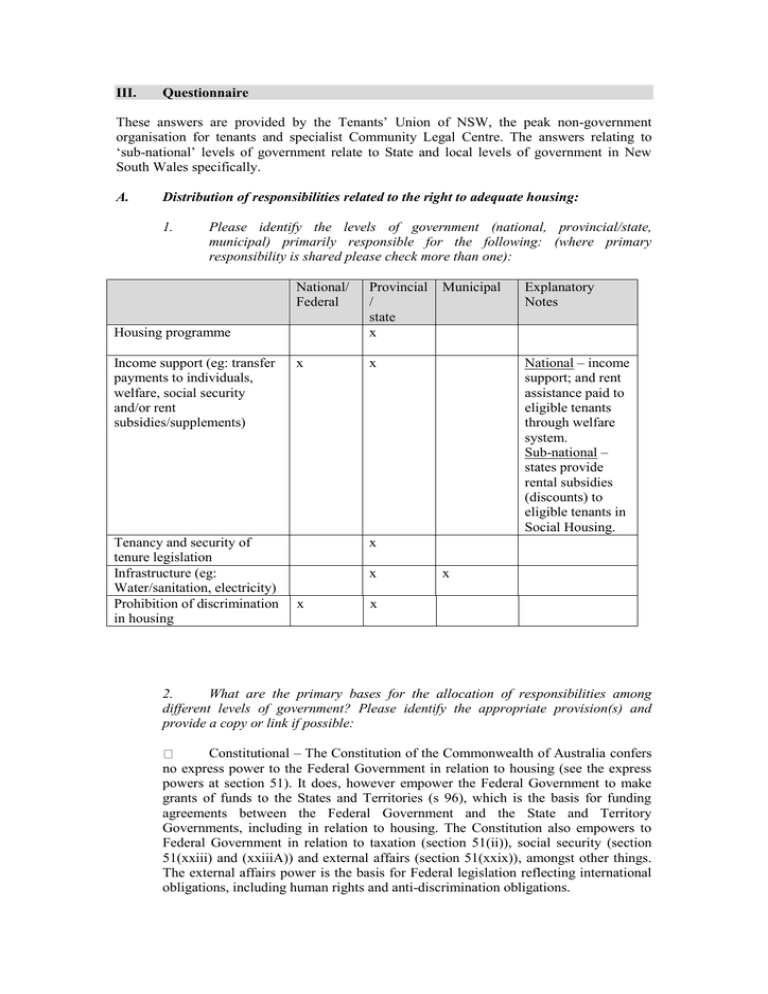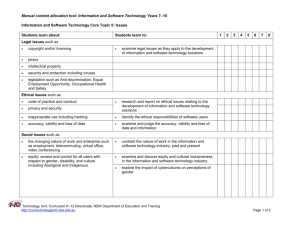III. Questionnaire These answers are provided by ...
advertisement

III. Questionnaire These answers are provided by the Tenants’ Union of NSW, the peak non-government organisation for tenants and specialist Community Legal Centre. The answers relating to ‘sub-national’ levels of government relate to State and local levels of government in New South Wales specifically. A. Distribution of responsibilities related to the right to adequate housing: 1. Please identify the levels of government (national, provincial/state, municipal) primarily responsible for the following: (where primary responsibility is shared please check more than one): National/ Federal Provincial / state x x x Housing programme Income support (eg: transfer payments to individuals, welfare, social security and/or rent subsidies/supplements) Tenancy and security of tenure legislation Infrastructure (eg: Water/sanitation, electricity) Prohibition of discrimination in housing Municipal Explanatory Notes National – income support; and rent assistance paid to eligible tenants through welfare system. Sub-national – states provide rental subsidies (discounts) to eligible tenants in Social Housing. x x x x x 2. What are the primary bases for the allocation of responsibilities among different levels of government? Please identify the appropriate provision(s) and provide a copy or link if possible: Constitutional – The Constitution of the Commonwealth of Australia confers no express power to the Federal Government in relation to housing (see the express powers at section 51). It does, however empower the Federal Government to make grants of funds to the States and Territories (s 96), which is the basis for funding agreements between the Federal Government and the State and Territory Governments, including in relation to housing. The Constitution also empowers to Federal Government in relation to taxation (section 51(ii)), social security (section 51(xxiii) and (xxiiiA)) and external affairs (section 51(xxix)), amongst other things. The external affairs power is the basis for Federal legislation reflecting international obligations, including human rights and anti-discrimination obligations. National framework legislation or housing strategy – There is no formal national housing policy. The most important national-level housing policy document is the National Affordable Housing Agreement, discussed at ‘Inter-governmental agreement’, below. Sub-national level legislation or housing strategy – There is no formal NSW State housing policy. The State Government legislation relevant to housing includes the Environmental Planning and Assessment Act 1979, which establishes the planning system administered by the State Government and local councils. This Act includes provisions that would allow local councils to require the creation of affordable housing as part of a development; however, the State Government has allowed these provisions to be used in only a few places. There is also an Affordable Rental Housing State Environmental Planning Policy 2009 (ARHSEPP) under the Act, which is intended to encourage the development of affordable rental housing by providing that development may be conducted in some circumstances where it would otherwise not be allowed under the development consent processes administered by local councils. It also allows for some local councils to require developers to make compensating contributions to the council where a development causes a loss of affordable rental housing. State legislation relating to housing rights include the Residential Tenancies Act 2010, the Boarding Houses Act 2012 and the Residential Parks Act 1998, which deal with the legal rights and responsibilities of landlords and tenants/residents; and the Housing Act 2001, the Aboriginal Housing Act 1998, and the Community Housing Providers (Adoption of National Law) Act 2012, which establish the social housing system. Inter-governmental agreement – The National Affordable Housing Agreement (NAHA)1 between the Federal Government and the State and Territory Governments is the basis for Federal funding of social housing and homelessness programs administered by the State and Territory Governments. The Federal and State and Territory Governments also collaborate on the National Regulatory System for Community Housing. Other – Not applicable 3. What role does the national level government play in relation to housing and related programs? The Federal Government’s largest influence on housing comes from its role in taxation. Federal tax settings – in particular, the exemption of owner-occupied housing from capital gains tax; the tax discount for capital gains from other asset classes, including rental housing; and generous tax treatment of negative gearing 1 http://www.federalfinancialrelations.gov.au/content/npa/housing/affordable/nationalagreement.pdf – encourage speculation in housing, which is resulted in persistent house price inflation, declining affordability (for purchasers and renters) and declining rates of homeownership. The Federal Government pays First Home Buyer Grants, which are administered by the State and Territory Governments. The Federal Government also pays, through the Federal social security system, Rent Assistance to eligible persons in private rental housing. The Federal Government also contributes funds, through the NAHA, to subnational government social housing and homelessness programs. The Federal Government also contributes funds, through the National Rental Affordability Scheme (NRAS), to private sector agencies for the construction of affordable rental housing; however, the Federal Government announced earlier this year that there would be no further rounds of NRAS.. Recently, the Federal Government has undertaken to review Federal-State relations and the distribution of roles and responsibilities between levels of government. It has indicated (with reference to section 51 of the Constitution) that it considers housing and homelessness to be State responsibilities, and may withdraw from involvement in social housing and homelessness programs (however, it has also indicated that it will not change its tax settings, which largely influence housing). How is compliance with the right to adequate housing structured between the national and sub-national levels? The right to adequate housing is not expressly adopted in Federal or State law. The NAHA makes no reference to a right to adequate housing but has instead expresses the aspiration that “all Australians have access to affordable, safe and sustainable housing that contributes to social and economic participation.” This aspiration is not litigable. Outcomes under the NAHA are monitored by the Council of Australian Governments. The Federal Government’s Productivity Commission also reports on the performance of State and Territory social housing programs. At State level, there is no express right to housing in social housing legislation. Decisions by a social housing provider about an individual person’s eligibility for social housing are subject to review by the provider and the NSW Housing Appeals Committee, but the HAC has no legislative basis and makes only recommendation, not binding determinations. There is no express right to housing in New South Wales residential tenancies legislation. The Residential Tenancies Act 2010 allows landlords to commence proceedings to terminate tenancies on a number of grounds, and also without grounds. Where a landlord takes proceedings (in the NSW Civil and Administrative Tribunal) for termination without grounds, the Tribunal must terminate the tenancy, without regard to the circumstances of the case (with one exception: the Tribunal may refuse to terminate if it is satisfied that the proceedings are retaliatory). Terminations without grounds are more common in the private rental system than in social housing, because it is well-established that a decision by the State social housing provider, NSW Land and Housing Corporation, to commence termination proceedings is subject to administrative law principles of procedural fairness, which require that the tenant be informed as to the reason for the decision. The NSW Land and Housing Corporation, therefore, almost always takes termination proceedings with grounds (for example, non-payment of rent). Decisions of the NSW Land and Housing Corporation are subject to judicial review by the NSW Supreme Court, according to the administrative law principles, but this rarely happens. These principles do not apply to private tenancies, and their application to community housing providers (nongovernment organisations funded by the State Government to provide social housing) is unclear. The use by community housing providers of termination proceedings without grounds appears to be increasing. The NSW State Government has recently indicated that it is considering amending the Residential Tenancies Act to remove the discretion of the Tribunal in proceedings to terminate social housing tenancies on the ground that the premises have been used for an illegal purpose (for example, the tenant or a household member has committed drug offences). This would mean, amongst other things, that the Tribunal could have no regard for circumstances such as the nature and seriousness of the offence, and whether any other innocent household members (which may include the tenant) would lose their housing. If possible please kindly provide concrete examples of how these roles and compliance mechanisms are operationalized. 4. Where sub-national governments hold key responsibilities in relation to the right to adequate housing, please describe how programs and policies are coordinated nationally and what responsibilities remain with national level institutions. Outcomes under the NAHA are monitored by the Council of Australian Governments. The Federal Government’s Productivity Commission also reports on the performance of State and Territory social housing programs. The National Regulatory System for Community Housing co-ordinates the Statebased regimes for community housing. There is little co-ordination of residential tenancies legislation. Each State’s and Territory’s legislation is roughly on the model recommended by the Federal Inquiry into Poverty in the early 1970s, but there are many differences in details between the jurisdictions. Each State and Territory periodically reviews and amends its laws, but mostly without regard to national best practice or consistency. 5. Where housing and related programs are administered by sub-national level governments, by whom and how are these programs funded? Are conditions attached to the funding which seek to ensure the resources are spent in a way that protects the right to adequate housing? How is this monitored? The Federal and State and Territory Governments jointly fund the housing programs administered by the State and Territory Governments under the NAHA. Outcomes under the NAHA are monitored by the Council of Australian Governments. The Federal Government’s Productivity Commission also reports on the performance of State and Territory social housing programs.. B. Accountability of Sub-National Governments 1. Are sub-national governments legally accountable to the right to adequate housing on the basis of any of the following? International human rights law? (Yes/No) Constitution/National Bill of Rights (Yes/No) National or sub-national legislation (Yes/No) State level or municipal level Bills of Rights/Charters (Yes/No) Inter-governmental agreements (Yes/No) Conditional financing (eg: budget transfers from national level to subnational) (Yes/No) 2. With respect to the above and where applicable, please identify: i. the relevant provision. ii. the sub-national levels of government to which the legal provision applies. iii. the means of enforcement (eg: courts, tribunals, national human rights institution, including ombudsmen, administrative mechanisms, etc.) and examples of how these means have been applied. 3. Are sub-national governments involved in State reporting to international human rights monitoring mechanisms and in implementing recommendations? (eg, UN treaty monitoring body, Universal Periodic Review). If so, how? Please kindly provide an example. No. 4. Apart from the legal and international accountability described above, what political or institutional accountability mechanisms are in place in your country through which sub-national governments are held accountable to standards or requirements linked to the implementation of the right to adequate housing (eg, Government review procedures, ombudsman/national human rights institutions, local human rights councils). Please provide any useful examples of how these have been used and, if possible, assess the outcome. The NSW Ombudsman investigates complaints of maladministration by the State’s social housing agencies (the NSW Land and Housing Corporation and Housing NSW). The NSW Registrar of Community Housing regulates community housing providers, but does not review individual decisions of community housing providers. The Tenants’ Union of NSW, Tenants Advice and Advocacy Services, and Community Legal Centres advocate for the housing rights of individual persons in legal proceedings, and for vulnerable people generally in housing policy and law reform processes. Other non-government organisations, such as Shelter NSW, the NSW Council for Social Service, and Homelessness NSW, also advocate for vulnerable people in housing policy reform processes. 5. Please kindly identify what in your view may be the three most significant challenges in your country to effective accountability of sub-national governments to the right to adequate housing as guaranteed under international human rights law and identify key strategies or ideas for addressing these challenges. Speculation in housing, encouraged by the tax system, has made housing (home purchase and rental) unaffordable for low- and moderate-income households, and made rental housing structurally insecure. There is no litigable or otherwise enforceable right to adequate housing in New South Wales or Australia. Under New South Wales residential tenancies law, tenancies can be terminated without grounds – landlords need not specify or justify their reason for ending a tenancy – and in proceedings for termination without grounds the Tribunal has no discretion to consider whether termination is appropriate in the circumstances of each case. Not only does this directly offend the right against arbitrary eviction, it also undermines tenants’ rights concerning the adequacy of housing – many tenants simply do not notify their landlords of problems with their housing for fear of eviction. The State Government has recently indicated that it may further restrict the discretion of the Tribunal in proceedings to terminate social housing tenancies on the ground of illegal use of the premises.





